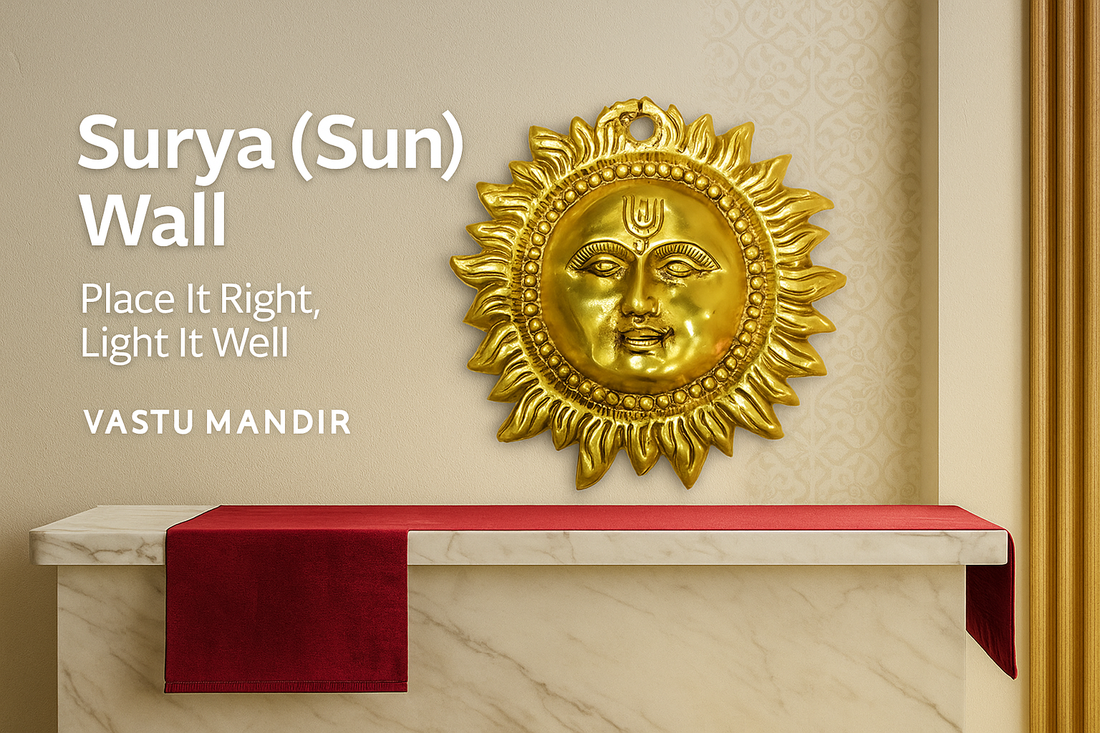
Surya (Sun) Wall: Direction, Height & Light (Modern Home Guide)
Vastu MandirShare
1) What Surya represents (in simple words)
Surya is daylight made visible—clarity, momentum, a clean beginning. On a wall, the Sun is less about display and more about setting the tone of a room. A well-placed Surya feels like opening the windows: the mood lifts, edges soften, and the space reads brighter.
2) Ideal direction: start with the east wall
-
Best: East wall—it symbolically welcomes morning light and a fresh start.
-
Good alternatives: Northeast (clarity) or North (steady flow) when the east wall is occupied.
-
Keep it visible: Choose the wall you can keep bright and uncluttered every day—that matters more than forcing a spot that will collect visual noise.
3) Height & proportion (so it reads instantly, not awkward)
-
Gaze height: Hang the Sun so its center lands near standing eye level—roughly the 145–155 cm band from the floor (adjust for your family’s height).
-
Above a console: Leave 15–25 cm between console top and the bottom of the plaque.
-
Sizing rule of thumb: If above a console/sofa, choose a piece about 60–75% of the furniture width (or create a tight grouping) so it reads strong—not tiny or overpowering.
4) Light that flatters brass (and doesn’t make it look cheap)
-
Colour temperature: Neutral-warm light (around 5000–6000K) keeps brass true and walls fresh; avoid blue-tinted LEDs that turn metals grey.
-
Quality: Aim for CRI ≥ 90 so details and flowers look natural.
-
Direction: A soft window key plus a gentle fill is enough. If you add an art light, keep glare low and avoid hot spots on the Sun’s face.
5) Backdrops & materials (create quiet contrast)
-
Wall finish: Jewel-tone plaster (emerald/indigo/teal), matte neutrals, or lime wash—no shiny vinyls behind the Sun.
-
Surrounds: Walnut/teak and honed marble read premium without shouting.
-
Avoid mirrors directly opposite or behind: the Sun should be the focal point, not a kaleidoscope of reflections.
6) Which room suits the Sun best? (and how to stage it)
Living room
Center the Sun over a console or sofa on the east wall. Keep the surface calm—one flower thali or a small urli is enough.
Foyer / entrance
A Surya near the entry feels welcoming. Make sure it sits clear of door swings and bag hooks; give it light and breathing room.
Pooja corner
If your tradition allows Surya art here, place it adjacent to the altar wall rather than behind the deities, so the flame doesn’t reflect and the Sun gets its own dignity.
Dining / family area
Choose a wall that’s seen daily—east or northeast—and avoid oil/steam zones.
Bedroom
If you like the idea, keep it small and calm, away from direct glare and not facing mirrors.
7) Hanging & alignment (the quiet details of “looking expensive”)
-
Straight verticals: Use a spirit level; crooked lines make even fine brass feel casual.
-
Centered with intent: Align the Sun to a centerline (furniture or wall panel), not randomly between two switches.
-
Hardware: Use two-point hanging or a sturdy cleat so the piece doesn’t swivel when doors open.
-
Cords & clutter: Hide them. Visual calm is half the work.
8) Styling the surface below (one statement, one whisper)
-
One hero, one friend: Let the Sun be the statement. Add just one quiet companion—perhaps a white bloom or a small bowl with petals.
-
Tray discipline: Keep keys, couriers, and chargers off this surface. The Sun should never compete with errands.
9) If the east wall isn’t available (gentle adjustments)
-
Choose northeast or north, then let light do the rest—add a soft art light or brighten the room overall.
-
If a mirror is already opposite, shift it or use a soft fabric panel or art that doesn’t reflect the Sun back at itself.
-
If the corner feels busy, remove items until the Sun reads clearly. Less décor, more presence.
10) Common missteps to avoid
-
Blue LEDs that make brass look cold and harsh.
-
Mirrors directly opposite or behind the Sun (restless reflections).
-
Hanging too high (floating away from the room) or too tiny above a large console.
-
Busy wallpaper fighting with the Sun’s geometry.
-
Clutter creep—mail, chargers, keys on the console beneath.
11) Warm reminders (instead of a checklist)
-
Pick the east wall if you can; otherwise northeast or north works with kind light.
-
Keep the Sun at a natural gaze height and give it breathing room.
-
Light softly, avoid cold/blue lamps, and keep reflections under control.
-
When the surface below is calm, the Sun feels dignified.
-
If something feels off, remove one item and check the light—clarity usually wins.







